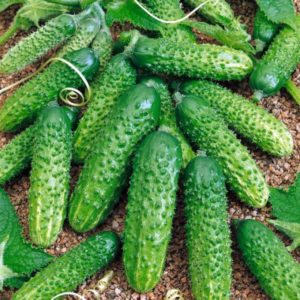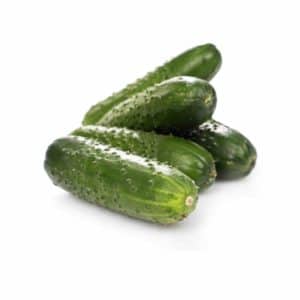What are the names of small cucumbers and what varieties of this type are the best?
Small cucumbers have a crispy texture and juiciness. They are used to prepare winter preparations, which are especially popular all over the world. Many people mistakenly assume that small cucumbers are underdeveloped large fruits.
In the article we will find out if this is true and find out what small cucumbers are actually called.
What are small cucumbers called?

Miniature cucumbers are called gherkins. The average length of one cucumber is 5-7 cm. Gherkins are used to prepare salads and snacks.
They are grown in the garden or garden, observing basic agrotechnical rules: watering, fertilizing and loosening the beds.
Origin story
The name “gherkin” came to Russia from France. The first mention of gherkins dates back to the 19th century. At that time, cucumbers began to be called “cornichots” - they were used to prepare assorted vegetables.
Later, gherkins began to be called all cucumber varieties with small fruits.
The best varieties of small cucumbers
Below we will tell you about the best varieties and hybrids of gherkins, learn the rules of cultivation and the secrets of a rich harvest.
Children's f1
The hybrid is resistant to major cultural diseases: root rot and tobacco mosaic. The vegetable is grown not only in the garden, but also on the windowsill or balcony. It is recommended to plant Children's seedlings to avoid diseases.
The size of the fruit varies from 4 to 10 cm, weight is about 50 g. There are small pimples on the surface.The thick peel and crispy flesh are suitable for preparing various dishes: pickles, fermented preparations, pickled salads.
Diva f1
An early-ripening hybrid ripens 35-45 days after the appearance of the first shoots. The length of the cucumbers is from 10 to 12 cm, the average weight is 100 g. The surface is ribbed, the shape is cylindrical, rounded towards the tip. The pulp is pleasant, sweetish, no bitterness. The yield is stable; summer residents harvest about 15-20 cucumbers from 1 bush. Gardeners value the hybrid for its consistent fruiting and commercial qualities.
Important! Thanks to their dense peel, Primadonna gherkins are perfectly transported over long distances and retain their taste and appearance.
Parisian gherkin
This famous variety gherkins refers to early ripening - the harvest is harvested 40 days after the appearance of the first shoots. Plant the Parisian gherkin in a garden bed or in a greenhouse. The vegetable is resistant to high humidity and sudden temperature changes. The length of the cucumber is about 6 cm, weight 40-60 g. The taste is juicy, the surface is ribbed.
The variety is universal in use; cucumbers are consumed both fresh and canned.
Son of regiment f1
The maximum length of a cucumber is about 8 cm. The shape is round, the peel is covered with white pimples. The pulp is fleshy, there are a lot of seeds, the taste is pleasant. The hybrid is valued for its ease of care, stable fruiting and versatility.
It is recommended for beginning gardeners to plant this gherkin: caring for vegetables does not require special agrotechnical skills.
Moth f1
Mid-early Moth is harvested 50 days from planting. The bushes of the hybrid are decorative and compact. The vegetables themselves grow elastic and crispy, the length of the gherkin is no more than 8 cm.Butterfly is suitable for preparing winter snacks - the vegetable does not lose its elasticity and retains its benefits.
Important! Gherkins contain potassium, which is necessary for the normal functioning of the kidneys and cardiovascular system. Eating gherkins removes excess fluid from the body and serves as a preventive measure for problems with the thyroid gland.
Puccini f1
The cucumbers are oblong in shape, with many small spines on the surface. The color is classic green, the flesh is sweet and juicy. From 10 to 15 fruits are removed from the bush at a time. The length of the vegetable is about 7 cm, weight 40-70 g.
The Puccini hybrid rarely gets sick and is not subject to insect pests. It has good shelf life and transportability.
Karapuz f1
Growing a gherkin in open ground or in greenhouses. They are planted with seedlings, having previously disinfected the seeds. The fruits are dense, uniform in color, rich green. The hybrid is distinguished by friendly fruit set and long fruiting. The taste is delicate, the purpose of the hybrid is universal.
The little one is resistant to cucumber mosaic and bacteriosis.
Thumbelina f1
The average length of a cucumber is 8 cm. The pulp is light green, there are many seeds. The taste is pleasant, the sweetness is moderate. The peel is thin, so it is recommended to consume or process the harvest within one to two weeks. Thumbelina is grown on the balcony or in warm and sunny beds.
How to choose a variety of gherkins for greenhouses

Gherkins are planted in greenhouses by gardeners from Siberia and the Urals. These regions have frequent winds and rains, sudden weather changes, and cool summers. Cucumbers need protection, so they are planted in polycarbonate or glass greenhouses, as well as in small greenhouses.
The best varieties for greenhouses - Primadonna, Moth and Son of the Regiment. Before planting, the walls and doors of the greenhouse are wiped with a solution of potassium permanganate, the ground is dug up and cleaned of debris.
For open ground
In open ground, the hybrids Detsky, Karapuz and Puccini take root. These gherkins are cold-resistant and rarely get sick. They are not afraid of frosts and heavy rains.
Gherkins are planted in open ground after greens, legumes, carrots or cabbage. The beds should be loose and nutritious, with neutral acidity.
Features of cultivation
Gherkins require more care than ordinary cucumbers.
Features of growing gherkins:
- In hot and dry summers, cucumbers are watered every day. Warm and clean water is used for irrigation. It is not the stem and leaves that moisturize, but the root.

- The plantings are kept clean - the beds are regularly weeded and weeds are removed. Loosen the soil once every 7 days.
- Gherkins are fertilized with mineral and organic fertilizers. Add ammonium nitrate, nitrogen, superphosphate, liquid droppings and mullein.
- A layer of mulch is regularly organized around the stem - sawdust, river sand, ash, and leaves are used. Mulch protects from the cold and nourishes the roots.
- To protect against pests, the drugs “Champion”, “Decis” or “Kurzat” are used.
- For prevention diseases spraying with Bordeaux mixture, copper sulfate solution, and the drug “Kuprostat” is used.
- Gherkins are not grown in the same area for more than two years in a row.
- The recommended planting pattern is 60x40. Thickened planting leads to the development of diseases and the appearance of pests.
- In cloudy weather, the beds are not moistened; in hot weather, they are watered in the early morning or evening.
How to choose small cucumbers when buying
The gherkins should be elastic and dense; lethargy is a sign of spoilage of the cucumbers.The color of ripe gherkins is uniform, without spots. The surface is pimply, slightly prickly.
The gherkins should not be too long, the maximum size is 10 cm. If you buy cucumbers at the market, make sure that they do not lie on the ground - this can lead to rapid spoilage of the vegetables.
How can I use it?
Gherkins can be used whole or cut into small pieces. The vegetable adds a pleasant sourness to dishes, making the taste more juicy and piquant.
Gherkins are found in the following dishes:
- solyanka;
- tartar sauce;
- liver cake;
- Olivie;
- pickle;
- roast beef;
- pizza.
The most common way to use gherkins is to prepare homemade pickles for the winter. Appetizing cucumbers are placed entirely in jars and look appetizing. Cherry tomatoes, carrots, onions, garlic, herbs and spices are added to the preparations. These pickles will be a harmonious addition to boiled potatoes, soups and side dishes.
Conclusion
Any gardener can grow gherkins. The main thing is to choose the right variety and know the secrets of care. For cool regions, resistant hybrids are suitable - Puccini or Children's, for the southern lands - Parisian gherkin.
Vegetables are harvested on average 40-50 days from the moment the first shoots appear. They acquire a green color, become crispy and fragrant. Gherkins are used to prepare salads and appetizers, soups and sauces.